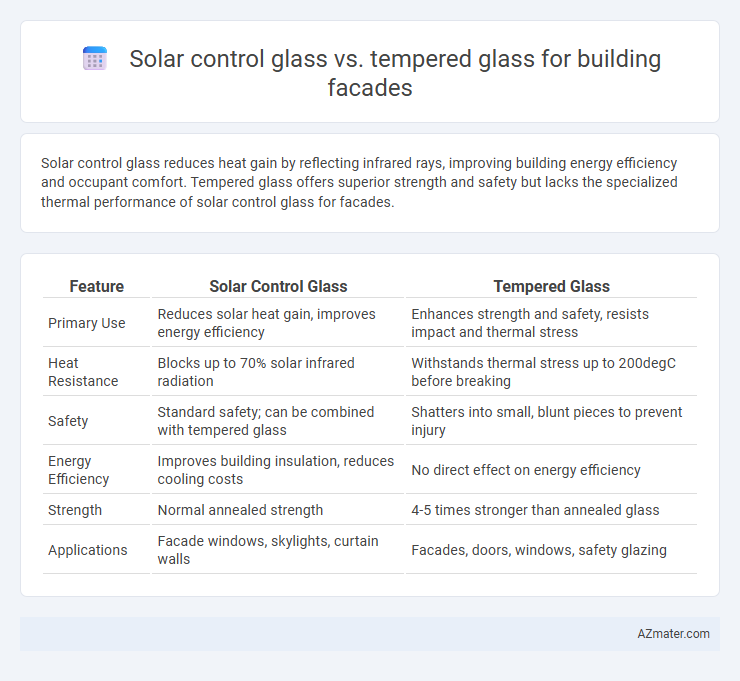Solar control glass reduces heat gain by reflecting infrared rays, improving building energy efficiency and occupant comfort. Tempered glass offers superior strength and safety but lacks the specialized thermal performance of solar control glass for facades.
Table of Comparison
| Feature | Solar Control Glass | Tempered Glass |
|---|---|---|
| Primary Use | Reduces solar heat gain, improves energy efficiency | Enhances strength and safety, resists impact and thermal stress |
| Heat Resistance | Blocks up to 70% solar infrared radiation | Withstands thermal stress up to 200degC before breaking |
| Safety | Standard safety; can be combined with tempered glass | Shatters into small, blunt pieces to prevent injury |
| Energy Efficiency | Improves building insulation, reduces cooling costs | No direct effect on energy efficiency |
| Strength | Normal annealed strength | 4-5 times stronger than annealed glass |
| Applications | Facade windows, skylights, curtain walls | Facades, doors, windows, safety glazing |
Introduction to Building Facade Glass Solutions
Building facade glass solutions include solar control glass and tempered glass, each offering unique benefits for energy efficiency and safety. Solar control glass reduces heat gain and glare while maintaining natural light, improving building comfort and lowering cooling costs. Tempered glass enhances building safety and durability through increased strength and shatter resistance, making it ideal for impact-prone applications.
What is Solar Control Glass?
Solar control glass is engineered with a special coating that reduces heat gain by reflecting and absorbing solar radiation, enhancing energy efficiency in building facades. It maintains natural light transmission while minimizing glare and UV radiation, contributing to improved indoor comfort and lower cooling costs. Unlike tempered glass, which is heat-strengthened for safety, solar control glass prioritizes thermal management and energy savings in architectural design.
What is Tempered Glass?
Tempered glass is a type of safety glass processed by controlled thermal or chemical treatments to increase its strength compared to normal glass, making it highly resistant to impact and thermal stress. Commonly used in building facades, it offers enhanced durability and breaks into small, blunt pieces that reduce injury risk. While solar control glass incorporates coatings or tints for energy efficiency by reflecting infrared and UV rays, tempered glass primarily ensures structural safety and resilience in facade applications.
Solar Control Glass: Key Features and Benefits
Solar control glass reduces heat gain by reflecting and absorbing solar radiation, enhancing building energy efficiency and occupant comfort. It typically features coatings that block ultraviolet (UV) and infrared (IR) rays while allowing visible light, improving glare control without compromising natural daylight. Compared to tempered glass, solar control glass contributes significantly to lowering cooling costs and reducing carbon footprint in building facades.
Tempered Glass: Key Features and Benefits
Tempered glass offers superior strength and safety for building facades, with a tensile strength up to four times greater than ordinary glass, significantly reducing the risk of breakage. It shatters into small, blunt pieces upon impact, minimizing injury and enhancing occupant protection. Its thermal resistance and durability make tempered glass an ideal choice for high-performance architectural applications where safety and longevity are critical.
Energy Efficiency: Solar Control vs Tempered Glass
Solar control glass significantly reduces solar heat gain by reflecting and absorbing infrared radiation, improving building energy efficiency and lowering cooling costs. Tempered glass, while stronger and safer due to its heat-treatment process, does not inherently provide solar heat reduction benefits. Choosing solar control glass for building facades enhances overall energy performance by minimizing reliance on air conditioning systems compared to standard tempered glass.
Safety and Strength Comparison
Solar control glass provides enhanced safety by reducing solar heat gain and minimizing glare while maintaining strong resistance to impact and weather conditions. Tempered glass offers superior mechanical strength, being four to five times stronger than annealed glass, and breaks into small, less harmful granules, improving occupant safety during accidental breakage. For building facades, combining solar control coatings with tempered glass optimizes both thermal performance and structural safety, meeting stringent building codes and occupant protection standards.
Aesthetic and Design Considerations
Solar control glass enhances building facades by reducing glare and heat transmission while maintaining high transparency, offering sleek, modern aesthetics ideal for energy-efficient designs. Tempered glass provides superior strength and safety with its uniformly toughened surface, allowing for larger, uninterrupted panels that create clean, bold architectural lines. Combining solar control coatings with tempered glass delivers both functional performance and visually striking facades, balancing sustainability with innovative design.
Cost Implications and Lifespan
Solar control glass offers significant energy savings by reducing cooling costs through its ability to reflect and absorb solar radiation, making it a cost-effective option despite its higher initial price compared to tempered glass. Tempered glass, known for its strength and safety features, typically has lower upfront costs but lacks the energy efficiency benefits, potentially leading to higher long-term operational expenses. Both glass types have comparable lifespans of around 20-30 years, but the reduced HVAC costs with solar control glass can result in greater overall value for building facades.
Choosing the Right Glass for Your Building Facade
Solar control glass effectively reduces heat gain and glare while maintaining natural daylight, making it ideal for energy-efficient building facades. Tempered glass offers superior strength and safety by withstanding impacts and thermal stress, essential for high-traffic or exposed areas. Selecting the right glass depends on balancing energy performance, safety requirements, and aesthetic goals for optimal facade functionality.

Infographic: Solar control glass vs Tempered glass for Building facade
 azmater.com
azmater.com